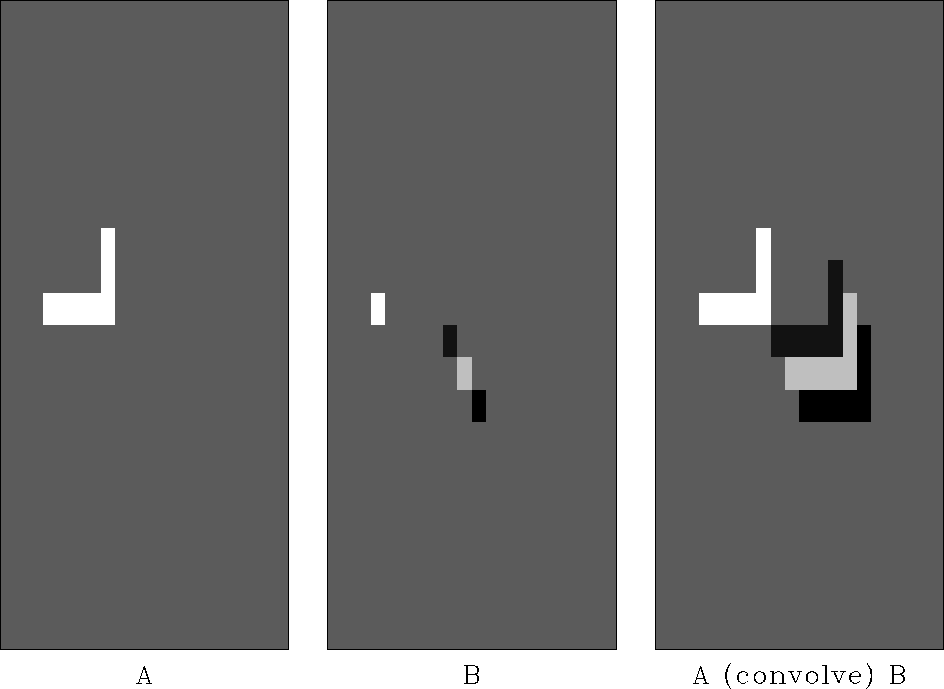 |
Figure 1 Two-dimensional convolution as performed in one dimension by module helicon
![[*]](http://sepwww.stanford.edu/latex2html/cross_ref_motif.gif) shows some two-dimensional shapes
that are convolved together.
The left panel shows an impulse response function,
the center shows some impulses,
and the right shows the superposition of responses.
shows some two-dimensional shapes
that are convolved together.
The left panel shows an impulse response function,
the center shows some impulses,
and the right shows the superposition of responses.
 |
A surprising, indeed amazing, fact is that
Figure ![[*]](http://sepwww.stanford.edu/latex2html/cross_ref_motif.gif) was not computed with a two-dimensional
convolution program.
It was computed with a one-dimensional computer program.
It could have been done with anybody's one-dimensional convolution program,
either in the time domain or in the fourier domain.
This magical trick is done with the helical coordinate system.
was not computed with a two-dimensional
convolution program.
It was computed with a one-dimensional computer program.
It could have been done with anybody's one-dimensional convolution program,
either in the time domain or in the fourier domain.
This magical trick is done with the helical coordinate system.
A basic idea of filtering, be it in one dimension, two dimensions, or more, is that you have some filter coefficients and some sampled data; you pass the filter over the data; at each location you find an output by crossmultiplying the filter coefficients times the underlying data and summing the terms.
The helical coordinate system is much simpler than you might imagine.
Ordinarily, a plane of data is thought of as a collection of columns,
side by side.
Instead, imagine the columns stored end-to-end,
and then coiled around a cylinder.
This is the helix.
Fortran programmers will recognize that fortran's way
of storing 2-D arrays in one-dimensional memory
is exactly what we need for this helical mapping.
Seismologists sometimes use the word ``supertrace''
to describe a collection of seismograms stored ``end-to-end''.
Figure ![[*]](http://sepwww.stanford.edu/latex2html/cross_ref_motif.gif) shows a helical mesh for 2-D data on a cylinder.
Darkened squares depict a 2-D filter
shaped like the Laplacian operator
shows a helical mesh for 2-D data on a cylinder.
Darkened squares depict a 2-D filter
shaped like the Laplacian operator ![]() .The input data, the filter, and the output data are all on helical meshes
all of which could be unrolled into linear strips.
A compact 2-D filter like a Laplacian,
on a helix is a sparse 1-D filter with long empty gaps.
.The input data, the filter, and the output data are all on helical meshes
all of which could be unrolled into linear strips.
A compact 2-D filter like a Laplacian,
on a helix is a sparse 1-D filter with long empty gaps.
 |
Since the values output from filtering can be computed
in any order, we can slide the filter coil
over the data coil in any direction.
The order that you produce the outputs is irrelevant.
You could compute the results in parallel.
We could, however, slide the filter over the data in the screwing order
that a nut passes over a bolt.
The screw order is the same order that would be used
if we were to unwind the coils into one-dimensional strips
and convolve them across one another.
The same filter coefficients overlay the same data values
if the 2-D coils are unwound into 1-D strips.
The helix idea allows us to obtain the same convolution output
in either of two ways, a one-dimensional way, or a two-dimensional way.
I used the one-dimensional way to compute the obviously two-dimensional
result in Figure ![[*]](http://sepwww.stanford.edu/latex2html/cross_ref_motif.gif) .
.